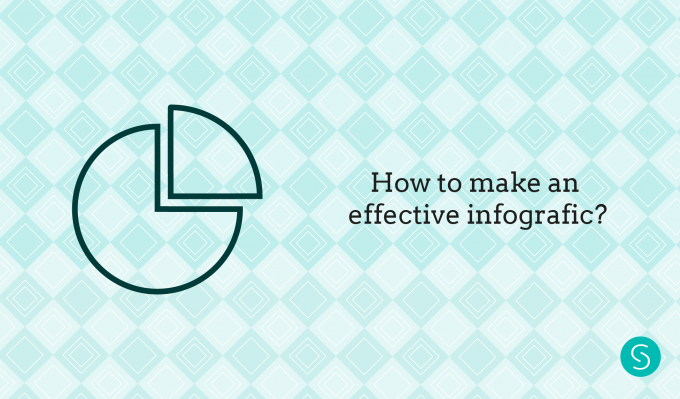Infographics are a trend nowadays. Everyone is using them, from companies to marketers. So it’s very important to know how to stand out from the crowd and make your infographic effective.
What’s an infographic?
In a nutshell, an infographic is a series of graphics that represent heavy information in order to make it understandable in a short period of time. Depending on the kind of information, the infographic will be only the summary of your report / post, or in other cases, it will be the whole report / post. This depends on how complex and how long is your information.
When do you should use infographics?
Infographics are great, they create a lot of engagement, and sometimes they go viral. But this doesn’t mean that they are advisable for every kind of information or company.
When you have to write numbers and percentages, infographics are great. Because it’s more attractive to show them on a graphic than simply write the numbers. People will pay more attention to it, and more important, they will remember it.
But, there is another kind of information that could be good on an infographic like, for example, a list of elements or to point out important facts.
The most important fact is that infographics tell a story, they are more related to comic and storyboard than you think. So, first of all, you need a story to tell.
How to share it?

Social media is very important on sharing infographics. Especially Pinterest, Facebook and Twitter.
But of course, this depends on your target, if your target is not on Pinterest, there is no point in sharing it on this social media channel. You have to know where your target is and then you have to choose the best channels among them.
Another good advice is to add social plugins to your infographic so people could share it on social media if they want to.
How to make an effective infographic?
-
Target: The first step to make an effective infographic is to define the target of it. In most cases this target will be the target of your blog or your potential client. But, still, it’s important to remember it and to have it present.
-
Goal: Second, you need a goal. What do you want to achieve with your infographic? Visibility? Inform people? Entertain them?Your goal has to be specific and quantifiable.
-
CTA: Your goal will lead you to a call to action. What kind of action will you want the reader to make? Share it? Reflect on something?You should write your CTA at the bottom of the infographic in order to invite people to do something.
-
Topic:Most people make the mistake of choosing a topic that most people are interested in. And this is a huge mistake. If you are a company or a self-employed you have to think about the topics that are interesting to your target because your main goal is to gain sales or potential clients. If you design an infographic with a viral topic you probably will get a lot of engagement, followers, and subscribers, but these people won’t ever buy you anything because they are not interested in your product or service.Think about your target necessities and then choose a topic that solves a problem for them, or give them important information.Focusing only on one topic is another good advice. It’s important because if you give a lot of different information, people won’t understand the core message of your infographic.
-
Core message: Define your core message. This is the message that you want to convey, the main one. The rest of the information will add value to this main message.
-
Information: As I said before, you need a story or a piece of information to tell. If you have a lot of information you will need to filter it because an infographic should have little text. To filter it, think which are the most important and original facts / data that you have on your text and put it on the infographic. And the rest write it on a series of paragraphs that go with the infographic.
A key is that you should only use data that is relevant to your goal. So ask yourself, will this information help me to achieve my goal?If you have only a few facts or data is very easy, you have to put all of them on the infographic.Use reputable and reliable sources. It’s a shame to design an infographic full of lies or with misleading information. You will loose clients and reliability. So make sure that your data is correct.
Besides, you should write an effective headline: a good headline is one that describes the information that is on your infographic, is concise, grabs user’s attention and is shorter enough to understand it at a glance. Example: “10 kinds of killer headlines.”
Finally, cite your sources. This is important especially when you are pointing out facts, example: “50% of people like infographics”, this kind of statements have to be linked to a reliable source.
-
Structure: Before designing anything, focus on structure. Which is the most important information? Which are the details? Where will you put the headlines? It’s very good to make some wireframes. This is very useful when designing websites, it’s the basic layout. Black and white and with only one font face. But, they are useful in another kind of designs too, like infographics, books, newspapers and so on. It gives you clearness and it helps you to know how to distribute the information in a coherent way.
-
Design: On an infographic design is a must. If you have a very interesting infographic but with poor design, you won’t get any result. Make sure that you follow your brand guidelines, as I explained on this post. If you don’t have any brand guidelines, a good advice is to limit your colour palette. Choose only 2 or 3 colours for the whole infographic.The same happens with typography, choose 2 different fonts at maximum. Use the exact font size that makes the infographic be read easily, without making any effort.Besides, use graphics that helps you to explain the data. There are a lot of kind of graphics that you can use, pie, bar, line and so on. To choose the correct one you have to think of the best kind of graphic that helps you to explain the information. It’s not important if you are a fan of pie chart, if this kind of graphic doesn’t fit with the information, don’t use it.
Another important element is the size. The limit is 735px wide and 5000 pixels tall. If you use a bigger size than this you will make your infographic uncomfortable to read because people will have to zoom in it. They will have to make an effort, and most people won’t do it. Besides, make the file as small as possible without loosing quality. If your file is very heavy it will make it uncomfortable for people to share it or keep it.
Use hierarchy. Most infographic has at first glance, a main image or graphic that grabs attention and have the core message, and then small details that add information to that core message.
Keep it simple: in design, this is a main rule. Don’t over design your infographic. Simpler graphics always win.
Have a balance between graphics and written information. Generally, an infographic will have more graphics and little text.
Add white space: this is another main rule in design. Don’t over charge your infographic. White space is good and very useful. Not only on an infographic, the same happens on websites, newspapers, posters, and so on.
Finally, don’t use white background: your infographic will be sharing it in multiple sources, social media, blogs… So if you use white background your infographic won’t stand out.
Where to find inspiration?
Inspiration is very useful when you have to create something. You don’t have to copy anything but it’s advisable to know what are your competitors doing and what other people did. So you could do something different and stand out from them.
Pinterest is a good place to find inspiration. You can look for an infographic of your same topic.
Google Images another good source. It will give you infographics and also blog post that talks about it.
This is a great website to find some inspiration too.
Another great website with lots of infographics for inspiration. They also have a lovely book.
Have you got any problems designing infographics? Let me know in the comments!

